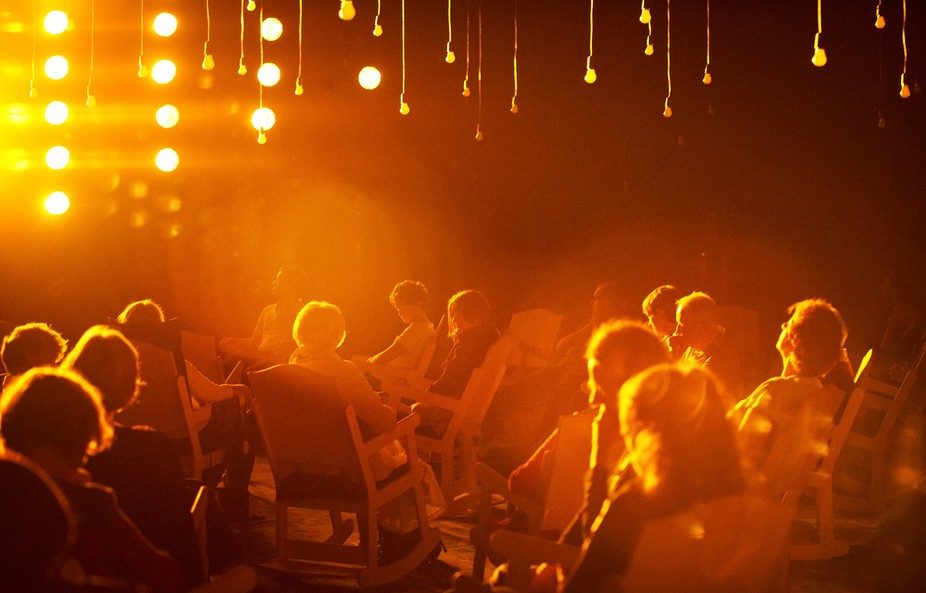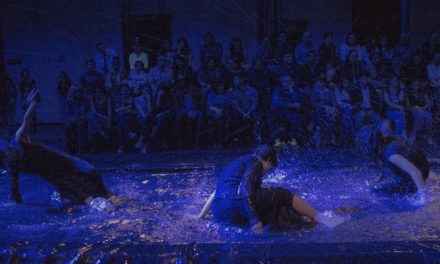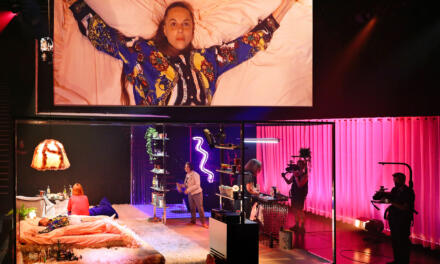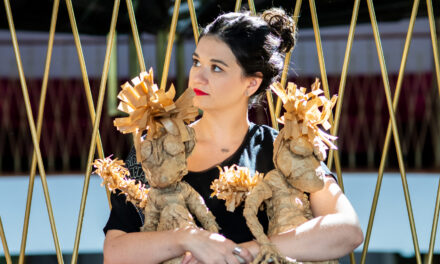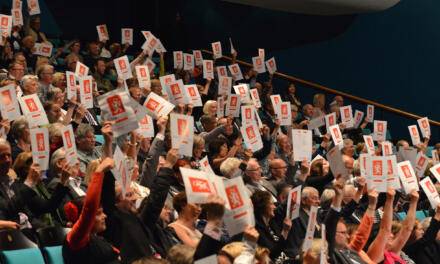In the program notes to Pan Pan Theatre’s outstanding production of All That Fall at the Sydney Festival, critic Nicholas Johnson underlines Samuel Beckett’s well-known opposition to having All That Fall, a radio play written in 1956, presented on stage.
He underlines how we need to get out of the cul de sacs of the stage history of works so as to imagine their present and future. Beckett’s concern with All That Fall related to the fact that he had specifically written it for the medium of radio: he did not feel it would be possible to adequately translate words and sounds emerging from the dark into words coming from bodies on stage.
This concern is, in effect, fundamental and hard to argue with: theatre is usually a medium of space and bodies and voices in that space in front of an audience; radio is a realm of sound and the voices and sound effects are restaged within the head of the listener. For this reason, many of Beckett’s radio plays include passages of inner dialogue where characters move from speaking aloud to thinking, from listening to others in the real world to listening to voices in their heads.
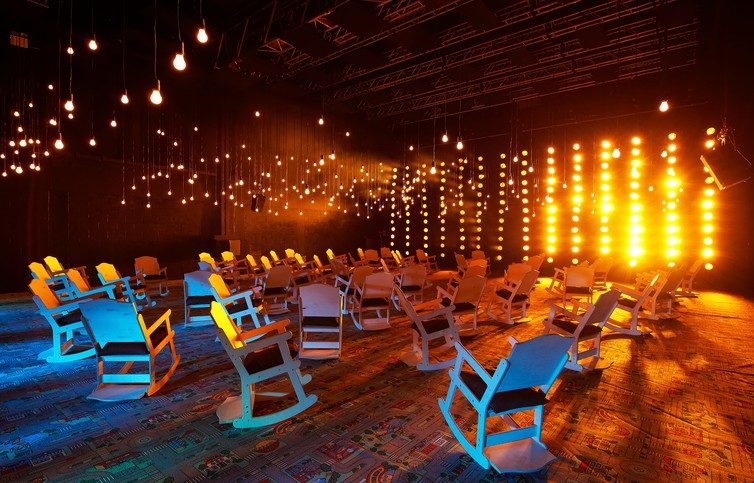
Pre-show set-up of All That Fall. Photo Credit: Ros Kavanagh/ Sydney Festival
Immersed in Beckett
The strength of Pan Pan Theatre’s production is that rather than seeking to draw All That Fall back into the traditional space of theatre they break the new work into elements — sound, light, the place of the audience within a space — that remain distinct but act in complementary ways.
The overall effect is to develop an immersive work that is similar in form to works of contemporary visual art that use light and space to shape the perceptions of audience members by isolating and stimulating particular senses. The work of artists such as James Turrell and Jim Campbell springs to mind.
In this production equal billing is given to the director Gavin Quinn, who works with a fine ensemble cast, the set and lighting designer Aedin Cosgrove who creates the immersive space in which we sit under hanging light bulbs facing a wall of spotlights, and the sound designer Jimmy Eadie, who records and mixes the actors and sound effects that are projected into our space from a powerful point in one corner of the room.
All That Fall contemplates the isolation of senses: Maddy Rooney is an obese woman who only moves with difficulty. The short trip from her haven to the railway station takes on epic proportions and is only undertaken because it is her husband’s birthday and she wishes to surprise him. Her husband struggles equally with movement and is blind. While this does not stop him from making his way to work each day it changes the nature of that trip.
Confused among the rocking chairs
The experience created by Pan Pan Theatre is sufficiently unusual that audience members at first struggle to understand their role.
The audience makes its way to a room that seems to exist in a space behind the main theatre: we walk past the normal stage and tiered seating to a room filled with rocking chairs, a wall of light and hanging bulbs and are told to fill from the front of the space. We struggle in with many taking some time to understand where to go.
When the play is over, people sit in silence waiting for some definitive cue from the players or space itself that everything is over. As the sound is recorded, no actors are present and the immersive lights remain po-faced, no such cue is forthcoming.
As we arrive and as we leave we notice the comfortable cushions on each rocking chair carry the image of a death’s head. The rocking chair appears in the pre-war novel Murphy, Beckett’s only film, Film, and in the late play Rockaby. The image links the cradle with the grave and is borrowed from the 17th-century philosopher Arnold Geulincx, who Beckett was almost alone in admiring in the 20th century, who used the image to explain suicide.
In Beckett those in the rocking chair (Murphy, Buster Keaton’s “O” in Film, and the woman “W” in Rockaby) are rocking themselves to death: a loop connecting old age childhood and death is established in the gentle rocking.
This loop is apparent in other motifs in Beckett: the messengers who lead or speak to the ageing protagonists are often young boys, such as the young boy at the end of each act in Waiting for Godot, or Jerry the young boy who leads Mr. Rooney and who finally explains the painful delay of the train at the centre of All That Fall. This latter is a delay that involves the death of a child; the only child, Minnie, it seems Maddy Rooney lost as a young mother many years before.
A performance that invites questions
Sitting in the immersive space created for this work the reviewer asks questions of the work, looking for things to comment on.
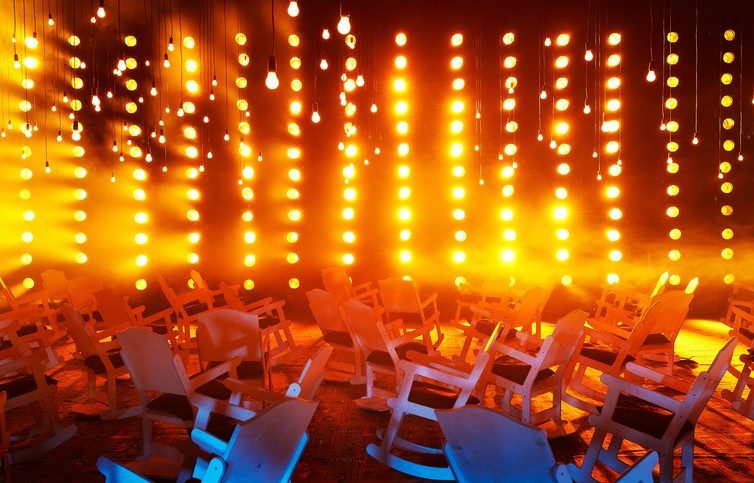
Photo Credit: Ros Kavanagh/ Sydney Festival
- How are the lights working with the text?
- Why does the sound come insistently from one corner rather than being dispersed about the space?
- Why are the sound effects so obviously fake?
To begin with, I thought of these as being problems and realized as the play continued that they were strengths. The experience of the play takes some time to establish itself. At first, things seem forced and awkward. There are animal sound effects to begin and these, rather than being realistic, are clearly human imitations of animals.
Beckett had a similar concern with the original BBC production: Donald McWhinnie at the BBC argued that real animal recordings would be less effective than human imitations while Beckett felt initially that the sounds should be real.
The effect in Pan Pan’s production is quite different from that in the BBC production in which the animal sounds are imitated more exactly. In Pan Pan’s production the sounds at first jar, but as the play continues they seem to be part of the mental landscape emerging from the minds of Maddy and Mr. Rooney.
The lights at first seem to rise and fall at random but as the play proceeds their counterpoint to the action draws us further into space. They are beautiful in themselves and don’t work in a symbolic way: they make us perceive at certain times but we look at the light the way we hear the music.
Meanwhile, the sound of the voices in the corner requires us to focus our attention and it builds to an impressive catastrophe with the sound effect of a tempest at the play’s end, which is loud enough to seem to shake the room. This is paired with the illusion of the lights on the wall building to the point of almost burning themselves out, as wisps of smoke emerge seemingly from within them.
The awkwardness at the beginning is overcome as the play proceeds and the actors draw us into their roles. The entire cast is strong in this regard, though the lead Aine Ni Mhuiri as Maddy Rooney holds the work together impressively: the contrast between the agoraphobic contempt for others she projects on the voyage out and the love she holds for Mr. Rooney on the voyage back to their haven is powerfully conveyed. Andrew Bennett is equally excellent as Mr. Rooney.
The play itself seems to have dated little, though the world described has much changed from ours.
The setting for this play is one of the most obviously local Beckett ever devised and closely resembles the small town of Foxrock just outside Dublin where he grew up. The train station was a short walk from his own home and the racetrack described in the play was nearby. That world in which rare automobiles forced bicycles from the road shared with genuine donkeys had already disappeared when Beckett wrote the play in 1956 and the train platform is now a ruin.
Yet through humor, the play leads us towards the persistent reality of suffering. It is a reality we struggle to accommodate or contemplate and it may be that visual artists, and masters of new performance such as Pan Pan Theatre, are right in thinking we need to be immersed in the problem before we will even try to think about it.
And so All That Fall soothes us with rocking while the bough is breaking.
This article was first published on www.theconversation.com on January 13, 2014. Reposted with permission of the author. Read the original here.
This post was written by the author in their personal capacity.The opinions expressed in this article are the author’s own and do not reflect the view of The Theatre Times, their staff or collaborators.
This post was written by Anthony Uhlmann.
The views expressed here belong to the author and do not necessarily reflect our views and opinions.

